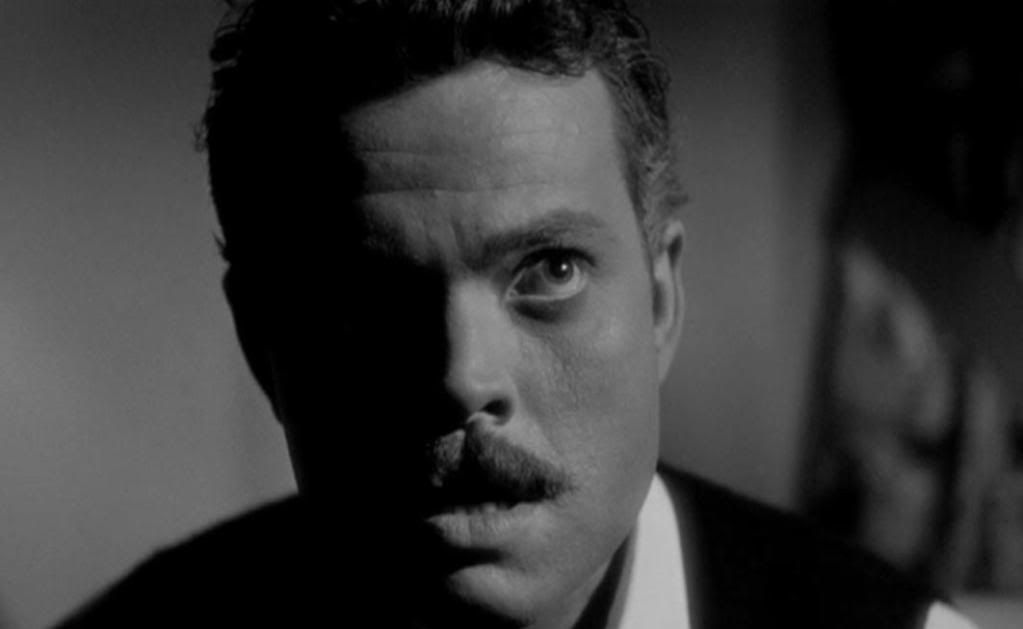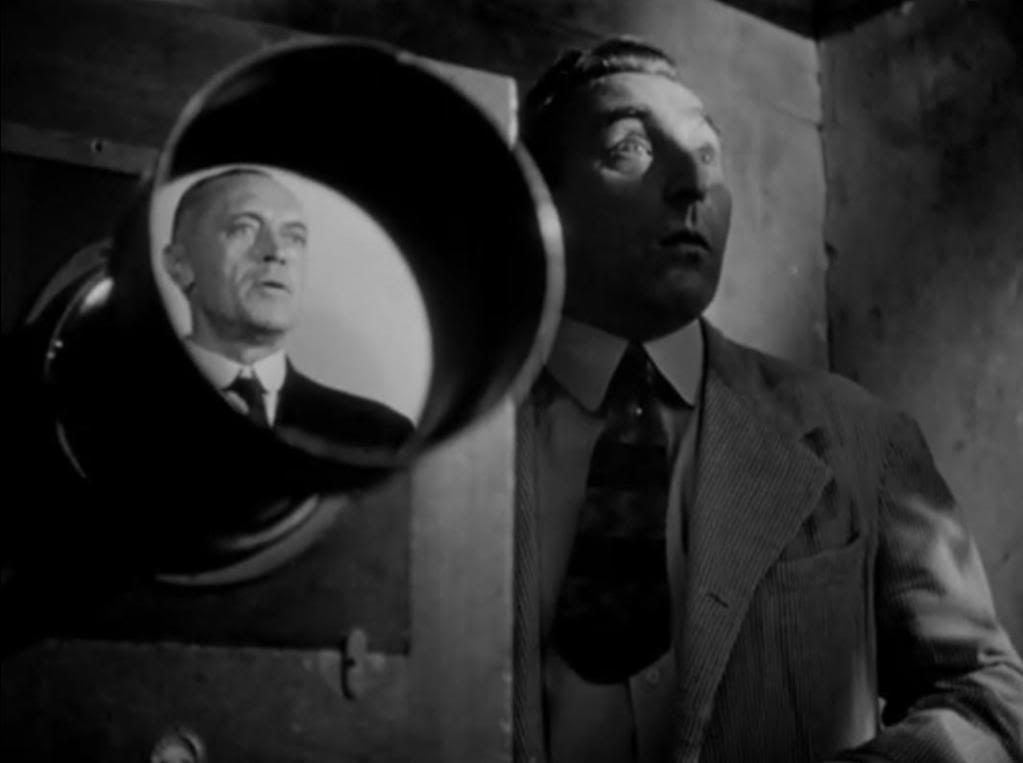
The Stranger is an unusual and somewhat awkwardly realized noirish thriller that was the third proper directorial feature of Orson Welles. It's a post-war suspense film about an escaped Nazi who disguises himself as an ordinary high school teacher in a small town in Connecticut. An officer for the war crimes commission, Wilson (Edward G. Robinson), is tasked with tracking down the elusive Franz Kindler (Welles), a mastermind of the concentration camps who, in the aftermath of World War II, has erased all trace of his identity and settled into suburban conformity. He's even marrying local girl Mary (Loretta Young), a naïve beauty whose father is a well-respected judge. Wilson arranges for the release of a lower-level Nazi prisoner, Meinike (Konstantin Shayne), in the hopes that the underling will lead them to the otherwise vanished Kindler. In the film's briskly paced but evocative opening — which Welles had wanted to be much longer, but the footage got cut by the studio — Wilson's detectives track Meinike through a South American port, where deep shadows are populated by silhouetted figures smoking on balconies, and mysterious women weave through back alleys passing messages between the men who hide in the shadows. This exotic opening sequence is a bit of clever misdirection, though, because at the end of it, Meinike finally gets in touch with the contact he'd been seeking, and finds out that Kindler is not hiding in some grimy, out of the way South American town, as so many Nazis did after the war, but is in fact in the quiet, normal little town of Harper, a place as quintessentially American as any place can be.
Welles immediately cuts from South American intrigue to North American small town life, creating a jarring disjunction in mood and style between the expressionist shadows of the opening and the brightly lit streets of Harper, a place that seems to have nothing to hide, no shadowy errands being conducted within its pleasant borders. As Mary says, cheerfully getting ready to walk home alone one night, "in Harper there's nothing to be afraid of." That's a big part of the film's essence, the infiltration of American suburban safety and security by the sinister evil of Nazism. Kindler's presence in this cheery, sunny little town is an affront to the idea that there's nothing to fear on America's pleasant home town streets.
As compelling as this theme is, the script is often clumsy in conveying it, and as with a lot of Welles' post-Kane studio-compromised works, the film has a lot of rough edges. Mary is the biggest problem, and Young is not given much to do with her performance. She remains loyal to her husband even as she starts learning troubling details about this man she loves, and starts seeing indications of the violence he's capable of. She reacts to each new revelation with renewed dedication to him, so her part basically consists of weepy declarations of love and devotion, until later in the film she begins breaking apart, shrieking and fainting constantly. At one point, after learning that the man she knew as Charles Rankin is actually the Nazi Franz Kindler, she runs through the nighttime streets, tearfully insisting, "he's good, he's good," locked into denial. It's an unfortunately one-note role that limits the woman in the story to either blind devotion or hysteria.


Welles and Robinson have much meatier parts, and the film focuses on the tense battle of wills between these two titanic actors. Though the script sometimes tends towards moral speechifying, their performances are strong enough to overcome the blunt nature of the words they're delivering. The real pleasure, though, comes from a few of the quirky bit parts. Meinike, the Nazi underling who kicks off the whole plot, is a fascinating figure, a sinister-looking creep who has, apparently, found religion while awaiting trial for his war crimes. He's tracking down his old boss hoping to convert him, it turns out, and the scene where he drops to his knees in the woods with Kindler and prays is oddly striking. Welles also gets some folksy humor out of Mr. Potter (Billy House), the rotund general store owner who puts on a visor to denote his seriousness every time he plays a game of checkers with his customers.
The film's most memorable scenes are the ones in which Welles and cinematographer Russell Metty allow an expressionist, shadowy noir style to infiltrate the mundane town of Harper. Hoping to shake Mary out of her delusions about Kindler, Wilson shows her footage of the concentration camps on a projector, and Welles includes real images from the camps — the first time this was done in an American film. Welles only shows selected shots from the camps, mostly keeping the cameras trained on the faces of Mary and Wilson, the flickering light from the projector flashing on their faces. The emphasis is on their reactions, the haunted look in Mary's eyes as she sees the horrifying piles of bodies and the evidence of the gas chambers. At one point, Wilson stands in front of the screen, casting his silhouette over the images, and then Welles cuts in for a closeup in which the images are eerily laid across his face. At a pivotal moment at the end of the scene, the tape stops with a loud clicking noise, startling Mary out of her awed reverie — and likely the film's audience with her.
Welles also makes inventive use of the town clock tower, which is an important locale because Kindler has a hobby — Wilson describes it as a "mania," because even the hobbies of Nazis must be creepy — of fixing antique clocks. Once Kindler repairs the long-malfunctioning clock, the deep, chiming bells that go off every once in a while sound a foreboding note, an aural signature, a reminder of the Nazi mastermind's presence in the town. The clock tower is also the site of the brilliant, chaotic climax, in which Wilson and Mary confront Kindler inside the tower, leading to an unforgettably prolonged death scene for the Nazi mastermind, who gets impaled on the sword of an angelic figure who makes the rounds of the clockwork mechanism, chasing a gargoyle-like devil. The symbolism and the irony are obvious, but the result is still affecting and haunting. The same can be said for the film as a whole, which is clunky and uneven but still deeply fascinating and, as usual with Welles, inventively staged.

7 comments:
Ranked usually near the bottom of Welles' body of work, but still a fun, intriguing movie, especially funny/creepy touches like Kindler subconsciously drawing a swastika while on the telephone. We have the original scripts at Lilly, which unsurprisingly were much longer and more detailed than what made it onscreen.
It's quite underrated -- even by Welles himself.
I'd heard he wanted Agnes Moorehead to play the invetigator but RKo nixed it.
Definitely underrated, I think it's quite good, even compromised/cut.
I had heard that about Moorehead too, I guess the studio execs couldn't imagine a woman leading the investigation and outwitting the villain. A shame, that would've been interesting, though of course Robinson is great.
Ed, I've always liked this film, even while admitting it isn't entirely successful. There are splendid moments, like the tracking of the fugitive in the opening reel and of course the celebrated climax where teh teacher is speared to death by one of the revolving sword-bearing effigies on the town clock tower. The obvious thematic similarities to SHADOW OF A DOUBT, GASLIGHT, SUSPICION and CAT PEOPLE in the "there's a sinister prsence among us" sub-genre give it an alluring narrative context, but there's no question at all that you identified what distinguishes it most of all and that's Russell Metty's shadowy, noirish cinematography. It is however a bit of clubky film at times, and uneven, and Mary (Loretta Young) is the biggest proble.
Warts and all I can watch this film any day, anytime.
As always, an exceptional essay here!
"Warts and all I can watch this film any day, anytime."
Yeah, that's how I feel too. It's far from perfect but it's a fascinating movie with so many great aspects. Part of it also that I really love the "evil among us" sorta-genre that you mention, to which I'd also add Paul Landres' underrated Return of Dracula.
I saw this years ago and was disappointed. Here's what I wrote on IMDB at the time: "I didn't like the film very much. It had its moments - particularly early and late in the film but the plot was contrived, the pacing off, and Welles' directorial flair only shot up in spurts. Too bad because it had quite a few things going for it: Welles as director, of course, but also the aforementioned flavor of the small town (I have to give Welles credit for achieving that atmosphere on a Hollywood backlot), and the confluence of world events and provincialism, but somehow the Nazi in Americana theme felt underutilized for much of the film. Mostly, I just don't think the screenplay was very effective."
I haven't seen it since, but maybe now that the letdown's out of the way, I'd be more forgiving? Or maybe not...
Moorehead would have been great, though it probably still wouldn't have transcended the material.
I can see being a little disappointed, it's a very imperfect film, but personally I'd say Welles' directorial flair is slathered all over it, and that's what makes it so enjoyable and interesting despite some very real script problems.
Post a Comment